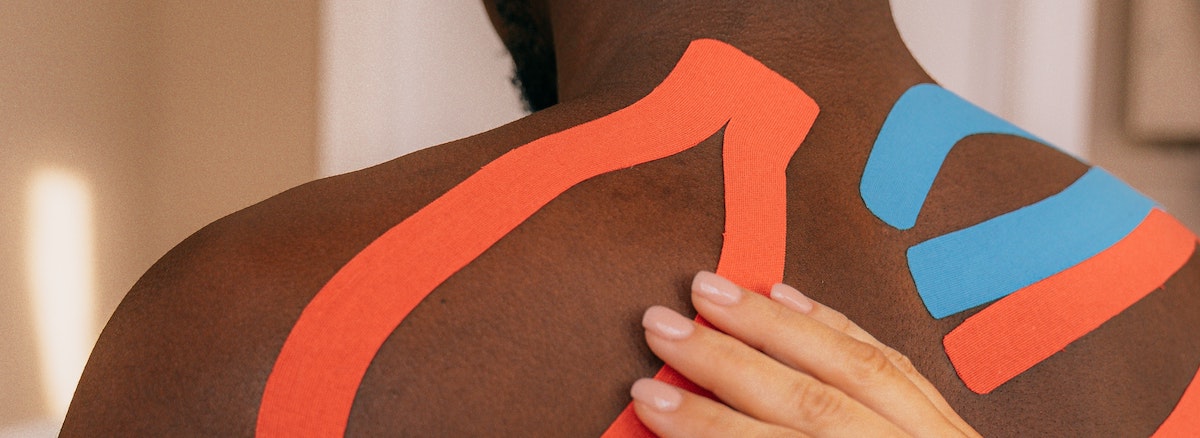
Does Kinesiology (coloured Physio tape) really work?
Nearly everyone will have seen this brightly coloured tape worn in sports, right up to the elite level, often in track-based sports. Used on calves, knees, shoulders, and pretty much everywhere else, you have to admit it looks professional and feels helpful. But does kinesiology tape really work, or are even elite athletes falling into the human behavior logic that if other people are using it then it must work?
The origins of Kinesiology tape
The tape has been around longer than you would think, having been developed in the 1970s by Kenzo Kase, a chiropractic doctor in Japan. Instead of using the established cotton-based inflexible medical tape, he wanted to create something that was more in line with human skin and its elasticity. Although it was used by professional athletes and therapists, it only went mainstream during the 2008 Olympics, particularly in volleyball, where a famous US player Kerri Walsh wore it on her shoulder and went on to win the gold medal.
What is it made of?
Kinesiology or physio tape is made from a blend of cotton, spandex and adhesive, which is what makes it different from non stretch traditional white tape that you might see in sports like rugby. Where this white tape is used to restrict movement, Kinesio tape is designed to stretch up to 40% of its original length while retaining its elasticity, thus providing support, but without hindering movement.
How is it supposed to help?
Kinesio tape is supposed to provide support, reduce pain, reduce swelling and improve athletic performance. Physical therapists claim it can help in several different ways, treating injuries, supporting weak zones, educating muscles, enhancing performance, and managing scars. Its benefits are widely thought to be twofold. Firstly, in creating space in the joints, and secondly, in inhibiting pain receptors that send signals to the brain when we are injured.
Creating space – when applied over a joint, the tape is supposed to increase the space within the joint. Although the space increase is said to be marginal it is enough to reduce pressure within the joint thus reducing tension and joint irritation.
Inhibiting pain receptors – some physical therapists also think the tape blocks receptors that send pain signals to the brain, making injuries less painful and faster to heal. All of our tissues – skin, connective tissue, muscles and fascia – have sensory receptors that feel pain, temperature and touch. These all contribute to our proprioception – our brain’s perception of our limbs in space; our innate sense of what our body is doing. Kinesiology or physio taping is supposed to lift the skin over the underlying tissues relieving pressure and reducing pain signals from the injured area to the brain. This additional space between the skin and underlying tissues is also claimed to help improve both circulation and lymphatic drainage.
Finally, it is also believed to help in the activation of muscles on muscle groups, For example, taping on a particular area can “wake up” the muscle and make sure is activated so that the body is moving and correctly propelling itself reducing fatigue and chances of injury.
Is there scientific proof that it works?
Not really. One of the issues is the lack of large recent studies but also the subjective nature of injuries, rehabilitation, and performance from individual to individual. In two reviews that looked at 18 studies between them, only 6-7 of the studies reviewed showed moderate benefits in the reduction of musculoskeletal pain. One of the reviews by the US National Library of Medicine stated:
“This systematic review found insufficient evidence to support the use of KT following musculoskeletal injury, although a perceived benefit cannot be discounted. There are few high-quality studies examining the use of KT following musculoskeletal injury”.
Some small studies do however show that KT tape was effective in increasing space in the joints, and easing pain from knotted muscles or trigger points. The most positive study results interestingly were regarding the use of kinesiology tape in the rehabilitation of the spine and shoulder, but no positive results were found for lower leg injuries.
Despite the lack of concrete scientific evidence for the effectiveness of Kinesio tape, many experts think there is a positive effect due to the psychological aspects of wearing the tape. Anecdotal evidence shows that there can be a placebo effect through wearing it – if people believe it’s working, it may actually make it effective. Studies have shown that even when people know they are taking a placebo, it still works! It is very much worth noting that many studies show the tape to be effective when used alongside traditional physiotherapy or exercise-based rehabilitation programs, or perhaps that the latter traditional treatments remain the most effective.

Recent Comments